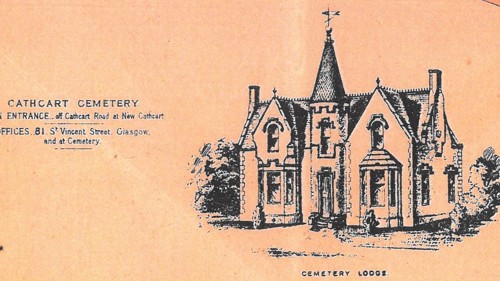Cathcart Cemetery - Times Past

In partnership with the Glasgow Times, our archivists are exploring Glasgow's fascinating history. This week, Nerys Tunnicliffe writes about Cathcart Cemetery.
Cathcart Cemetery opened officially in 1878, during the height of the ‘garden cemetery’ movement. Its wooded and semi-rural setting just beyond the city boundaries was typical of this new type of burial ground.
The movement was a response to the over-populated city cemeteries and growing sanitation concerns caused by outbreaks of disease such as cholera. The new ‘garden’ cemeteries were planned out with carefully laid out grounds, and strict rules governing the specifications and design of burial plots.
The famous Paris cemetery of Pere Lachaise had also inspired the idea of cemeteries as attraction grounds. Death and mourning were fashionable in the Victorian age. Garden cemeteries were intended to be visited as spaces to take the outdoor air whilst admiring ornate and picturesque tombs.
The trend for large decorative memorials couldn’t be catered for easily within smaller burial grounds such as that of ‘Old’ Cathcart Churchyard at Carmmunock Road which the new cemetery replaced. Members of the Cathcart Parish Board set up The Cathcart Cemetery Company and purchased lands from the Bogton Estate (the same estate’s lands also make up part of today’s Linn Park). The site was near enough to visit from the city, and old estate’s lands were mainly agricultural making the site ideal for a garden type cemetery. William McKelvie, a former Superintendent of Cemeteries and Parks at Greenock whom had also worked at the Glasgow Necropolis, was employed to plan the new grounds. Today there are around 15,000 graves on the 43 acre site.
One of the most striking memorials is the Egyptian style William and Mary Hood Mausoleum, constructed in 1900 by monumental sculptors Scott & Rae out of red polished granite. Said to be inspired by the Philar Temple of Hathor, with its grand pillars and gates, it once included statute of Anubis the Jackal (the Egyptian lord of the dead). William Hood was a successful butcher, and later a Justice of the Peace, who according to his obituary also enjoyed travel throughout Europe, Africa and of course Egypt. The Scott & Rae’s estimate for the mausoleum in our archives records a cost of £1311 and 11 shillings, a considerable sum at the time.
Notable burials include Margaret Metcalfe Jefferson the mother of Stan Laurel, Gaelic opera singer Jessie MacLachlan, Celtic manager Willie Maley and Rangers manager William Wilton, and more recently artist Hannah Frank.
Cathcart Cemetery’s grounds are still lovely to visit today, even though the residential area has grown around it. It still maintains leafy surroundings, bordered by Linn Park and the White Cart Water, a place to pause and reflect on the past.

